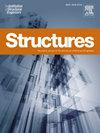Shake table tests of prestressed precast segmental bridge columns under bidirectional earthquake motions
IF 3.9
2区 工程技术
Q1 ENGINEERING, CIVIL
引用次数: 0
Abstract
Precast segmental bridge columns are commonly used but merely in low-seismicity areas, since their seismic performance is not clear under actual earthquake motions. To evaluate the feasibility of precast segmental columns in high-seismicity areas, it is necessary to investigate the dynamic behavior of such columns under bidirectional seismic excitation owing to multi-dimension characteristics of earthquake ground motions. Two 1/10-scaled columns with continuous low-carbonated rebars between segments were designed and reinforced with ultra-high-performance concrete (UHPC) based on a proposed design method. Then, shake table tests of reinforced columns were conducted to investigate the influence of types of seismic motions (near-filed and far-field) and loading direction (unidirectional and bidirectional) on dynamic responses of precast columns. The experimental results showed that minor concrete damage occurred in the bottom segment, and 0.2 % residual displacement was found, which indicated the column had an excellent re-centering capacity. Compared with the column under unidirectional seismic excitation, the column subjected to bidirectional seismic excitations had more serious concrete damage, more obvious fundamental frequency reduction, and larger displacement responses at the column top, residual displacement, and peak stress of tendons. The displacement of the column top under bidirectional loads was twice that under unidirectional loads. In addition, the response of the column under near-field earthquake motions was more significant than that of the column under far-field seismic excitations.
求助全文
约1分钟内获得全文
求助全文
来源期刊

Structures
Engineering-Architecture
CiteScore
5.70
自引率
17.10%
发文量
1187
期刊介绍:
Structures aims to publish internationally-leading research across the full breadth of structural engineering. Papers for Structures are particularly welcome in which high-quality research will benefit from wide readership of academics and practitioners such that not only high citation rates but also tangible industrial-related pathways to impact are achieved.
 求助内容:
求助内容: 应助结果提醒方式:
应助结果提醒方式:


